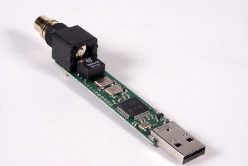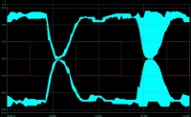Interesting Stories about Audio & Home Entertainment technologies
Last update: Jun. 05, 2012
USB-S/PDIF CONVERTER
M2Tech hiFace Two

The original hiFace was probably one of the first USB interfaces widely accepted, based, mainly, on audiophile criteria. M2Tech capitalized on its success for sure, offering some quite interesting products since, such as the hiFace Evo family and a complete DAC capable of 32/384 streaming, the Young. During our visit to the Munich High End Show some weeks ago, M2Tech also announced that the Vaughan, their flagship DAC model, will be available shortly.
The new version of hiFace, named simply hiFace Two, offers the same streaming capacity as the first model at 24bit/192kHz, in asynchronous transfer mode (meaning that the interface and not the computer dictates the rate of the data transfer). Additionally, compatibility with ASIO mode is included for further versatility. There is no need to install any driver if your playback system is based on a Mac or Linux computer but, as usual, you will need to do some downloading and installation in PC platforms if you want to use sample rates above 24/96.
The new interface uses the same plastic cover (the sample offered for this review was in black color) and has the same dimensions with the original, being a little bigger than a typical flash memory (102x22x20 mm). The S/PDIF output is provided via a good quality RCA plug with a BNC female being an alternative.
Details
The hiFace Two is based on the well known XMOS solution for USB to S/PDIF conversion. The USB stream enters through a transceiver chip (USB3318) clocked at 13MHZ, while two different crystal oscillators are used for the clock circuit, one at 24.576MHz (for the 48kHz derived sample rates) and one at 22.5792MHz (for the 44.1kHz derived sample rates). This appears to be the best approach for systems that are capable to lock on all the usual clock rates from 44.1kHz up to 192kHz. The output is electrically isolated by the use of a small pulse transformer. Overall, build quality is typically good for the price.
Lab Results
Jitter susceptibility appears to be low, with all the graphs in the relevant diagram being under 130dBFs, hiFace Two therefore offers -indeed- some good isolation against the timing problems the USB could impose to the signal. Eye patterns of the S/PDIF output are also quite good both at 44.1kHz and at 96kHz, showing only some high frequency noise. The eye-opening remains well inside the limits (as indicated by the red rectangle in each diagram) in both cases. Using a 1kHz tone and some bandwidth limiting in the oscilloscope, the eye patterns at 96kHz appears more clearly. The clock jitter (measured at the zero cross points) was about 4.2nS.
Listening
During the listening sessions, hiFace Two replaced the USB interface I use in regular basis, the dCS Puccini U-Clock. The S/PDIF output was connected to a Teac Esoteric D70 converter. The media player part of the system was a netbook running Win7 and foobar2000. Installation of the driver was straightforward with no problems at all and the playback was at WASAPI mode. Direct connection to a USB port in a computer needs some attention though. Depending on the computer height, the hiFace Two sometimes is just hanging out transferring any force from the coaxial cable directly to the USB connector. In rare cases, this leads to a disrupted connection. The sessions included both standard and high resolution tracks. Relevant session recordings (24bit/192kΗz sampling of the D70's analog output) could be found and downloaded at the end of this page along with reference tracks, using the Puccini U-Clock/Esoteric D70 combination).
First impression of the hiFace Two was that of extremely good transparency. Obviously the artifacts introduced by the interface (if any…) are quite small, therefore the listener is free to feel recording's quality and the details included. The sound stage appears to be very well focused, with good dimensioning both in the horizontal and the depth axis, property which is mostly appreciated in small ensemble recordings with well defined musical instrument positions.
The transparency offered by hiFace Two allowed the rest of the system to show its known sound attributes, namely the detailed lows and good rhythm, the good layering and balance of mid band and the openness at highs. In direct comparison with our reference, hiFace Two sounded slightly more vague in detail and a little bit softer at the attack part in some instruments envelope (like the piano or the vibraphone), but the inevitable conclusion is that of a well balanced system.
Conclusion
To be honest, the differences between the original hiFace and this second version of it appears to be rather small, but with this price tag, M2Tech's hiFace Two interface ensures good isolation between the computer and the DAC with low jitter susceptibility and it appears to be transparent offering good value for money.
Equipment used during listening sessions
Teac Esoteric P70/D70, Nirvana DC-110, dCS Puccini U-Clock, Melos Plus Series Line, Copland DRC-205, Parasound HCA3500, ATC SCM-50PSL
LISTENING SESSIONS
The following recordings were made with a DV-RA1000 Tascam master recorder (using 24bit/192kHz sample rate) and you can download them to have an impression of what the device under review sounded like. It is obvious that any recording of this kind could not be absolutely transparent but, according to our experience, the majority of sound attributes we listen to, during the actual listening sessions, are preserved. The file format is .wav, so expect that the zipped files will be quite large (even if the clips are about a minute or less long. You could use a ABX listening plug-in like the ΑΒΧ plug-in for foobar2000 if you want to make some more elaborate experiments. Contact is if you have any questions.
TRACK LIST:
M2Tech hiFace Two
| Specifications (Data according to the manufacturer) | |
|---|---|
| Desription: | USB-S/PDIF Interface |
| Input: | 1xUSB A type male |
| Output: | 1xRCA or BNC female (optional) |
| Sample rates: | 44.1kHz, 48kHz, 88.2kHz, 96kHz, 176.4kHZ, 192kHz, 16/24 bit |
| Power Supply: | from USB bus |
| Dimensions: | 102x22x20 (mm, dxhxw) |
| Weight: | 50gr |
| Price & More Info | |
|---|---|
| M2Tech hiFace Two: | €140,- (price for the Greek market) |
| More Information: | web: http://www.m2tech.biz/ |
| Review Sample | AudioSoul |








